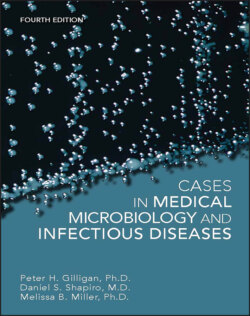Читать книгу Cases in Medical Microbiology and Infectious Diseases - Melissa B. Miller - Страница 64
CASE 9
ОглавлениеThe patient was an 18-day-old female who at initial presentation was brought to the emergency department by her mother after a 3-day bout of coughing. Her mother also reported that her daughter had been “spitting up” more than usual and had episodes of tachypnea. During the initial exam, a rapid respiratory syncytial virus test was obtained with negative results. A review of systems was notable only for a nonproductive cough. Her pulse was 168 beats/min, her respiratory rate was 32 inspirations per minute, and oxygen saturation was 92 to 95% on room air. Her complete blood count was significant for a white blood cell count of 15,300 cells/μl with an absolute lymphocyte count of 10,900 cells/μl. The mother had a chronic cough of 4 weeks’ duration but had been afebrile. Six weeks before this patient’s admission, her 10-year-old brother also had a prolonged coughing illness that responded to breathing treatments and inhaled steroids.
After initial examination, the child was admitted to the hospital. Her initial hospital course was uneventful, and she was discharged after 2 days. However, she was readmitted the following day with worsening respiratory symptoms. Over the next several days she had increasing difficulty breathing, tachypnea up to 100 breaths per minute, and oxygen saturations in the low 80s during coughing episodes. She was admitted to the pediatric intensive care unit for respiratory support. She had an extremely complicated and prolonged intensive care unit course that included pulmonary hypertension, acute respiratory distress syndrome, and health care-associated pneumonia. After a 10-week hospital stay, she was eventually discharged to return home, where her recovery was uneventful.
1 1. Nucleic acid amplification testing (NAAT) was performed on a nasopharyngeal swab. The amplified DNA was screened for a particular agent with positive results, and the patient was begun on azithromycin. What was the etiologic agent infecting this patient? What findings in this case support this conclusion?
2 2. Why is a nasopharyngeal specimen superior to any other clinical specimen for diagnosing this infection? Why has NAAT replaced culture for the diagnosis of this pathogen?
3 3. Describe the clinical course of this disease. Why didn’t the patient respond to the antimicrobial she was given?
4 4. What about the pathogenesis of this disease puts this patient at increased risk for health care-associated pneumonia?
5 5. A vaccine exists to prevent infections such as the one in this patient. Explain why and how this patient was infected. What does this case tell you about the vaccine? Vaccine strategies for preventing infections with this organism have recently changed. What changes in the vaccine are making better prevention possible? In particular, what groups of individuals should receive this new vaccine?
6 6. What type of isolation precautions should have been used while this patient was in the hospital? What therapy (if any) should have been provided to health care workers in close contact with this patient prior to institution of appropriate precautions?
